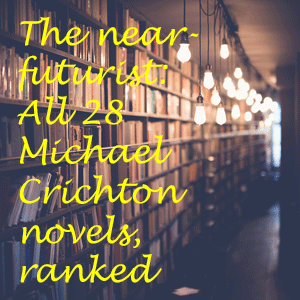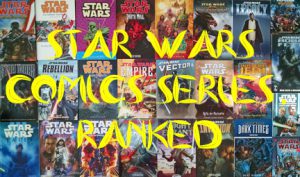With the new ongoing Marvel comic series, not to mention the trailers for “Episode VII” and “Rebels” Season 2, drawing interest from new and casual “Star Wars” fans, I thought it’d be a good time to look back at the ongoing “Star Wars” comic titles from the now-defunct Expanded Universe (a.k.a. Legends) era of 1977-2014. While Disney is focused on its own continuity, it’s often the case that new fans become curious about old stuff along with the new stuff.
If you’re one of those people, here’s a handy guide to the eight long-running “Star Wars” titles from Dark Horse (and Marvel, way back when it first held the license), ranked by me after completing an intense re-read in recent years. “Long-running” here is defined as series that lasted at least 30 issues. Click on the link for each title and Wookieepedia will break down the details of each series and tell you what trade paperbacks and omnibus collections the issues can be found in. You can also find links to my more detailed reviews here.
1. “Legacy” (2006-11, 50 regular issues, plus six-issue “War” miniseries) – Nearly a decade before Disney rebooted the “Star Wars” universe so its writers and directors could tell their own stories unencumbered by continuity, John Ostrander found a more palatable way to do it: by jumping a few generations into the future. “Legacy,” most of which features the crisp and kinetic art of Jan Duursema, takes familiar elements (Jedi, Sith, Empire, Republic) and plays with them in new ways, with Luke’s descendant Cade Skywalker (pictured above) as the main character.
2. “X-Wing Rogue Squadron” (1995-98, 35 regular issues plus Wizard No. ½ and Apple Jacks Special) – Michael Stackpole’s “X-wing” work was the most down-to-earth portion of the sweeping “Star Wars” mythology, starring Wedge Antilles, the GFFA’s consummate Everyman. Sure, it featured hotshot pilots and top military minds, but their concerns were with family, friendships, relationships and careers – along with some occasional big-picture philosophizing. While the comics are rougher around the edges than the novels, and the Search for Syal Antilles arc went unfinished due to the title’s cancellation, we do get important backstories (notably that of Baron Fel) and an opportunity to see novel characters brought to artistic life.
3. “Dark Times” (2006-13, 32 regular issues plus “Blue Harvest” No. 0) – Springing from the end of “Republic” and “Revenge of the Sith,” Dark Horse editor Randy Stradley (going by a variety of pseudonyms) gave us the moodiest “Star Wars” series, chronicling Dass Jennir and K’kruhk, who do good Jedi deeds while trying to stay off the Empire’s radar, and Bomo Greenbark, a mild-mannered Nosaurian who becomes vengeful when the Empire and its minions kill his family. The warm makeshift family of smugglers on the Uhumele contrasts nicely with the grim stories, and it’s beautifully enhanced by Douglas Wheatley’s meticulous painting-style art.
4. “Republic” (1998-2006, 83 regular issues, plus related miniseries such as “Jedi Council: Acts of War,” “Jedi,” “Obsession” and “General Grievous”) – First, it gave us an ongoing story of various Jedis between Episodes I and II, then it jumped ahead to give us the first chronicle of the Clone Wars, before George Lucas’ TV version. The breakout stars here were villain Asajj Ventress (mostly chronicled by Haden Blackman), who would be repurposed for the TV show, and troubled Jedis Quinlan Vos and Aayla Secura (mostly chronicled by Ostrander, with art by Duursema). Anakin and Obi-Wan popped in often enough to provide a connection to the films.

5. “Knights of the Old Republic” (2006-12, 50 regular issues, plus No. 0 and five-issue “War” miniseries) – John Jackson Miller burst onto the scene with this chronicle of a wrongly accused fugitive Jedi, Zayne Carrick, that – despite the harrowing premise – was freewheeling fun. While the story sometimes ran off the rails a bit and the art is inconsistent, Zayne’s friendship with the scheming Gryph and romance with the mysterious Jarael kept me turning the pages. I found that it came to a sputtering end without explaining the Republic versus Mandalorian war, but players of the “Knights” video game might appreciate the full story better.
6. “Empire”/“Rebellion” (2002-08, 40 regular issues of “Empire” and 16 regular issues of “Rebellion,” plus “Rebellion” No. 0) – These titles were an effective outlet for telling iconic stories between Episodes IV and V that had surprisingly gone untold. Highlights include idealistic Leia learning her first, harsh lessons about wartime decisions in an arc partly adapted from Brian Daley’s radio drama; and Biggs Darklighter’s complete journey from Imperial officer to Rebel pilot, which stands as a counterpart to Luke’s coming-of-age journey with its sad ending. Also compelling is the ongoing contrast between Luke and another old friend, Janek “Tank” Sunber, who has many of Luke’s values but believes the Empire is a better means to an end than the Rebellion. Many issues feature vibrant art by Davide Fabbri.
7. “Tales of the Jedi” (1993-98, 34 regular issues split into seven miniseries, plus “Golden Age of the Sith” No. 0) – The groundbreaking nature of this title by Tom Veitch and Kevin J. Anderson can’t be understated, as we got our first look at the time before Episode IV – and 4,000 years in the past, at that. Various artists blended beige Egyptian style architecture, both in buildings and spaceships, to provide an ancient feel, even though the technology is familiar. The writers delved more deeply into Jedi philosophy, introducing things like holocrons, and this saga still holds up even with Lucas redefining some Jedi ideals in the prequel trilogy.
8. Marvel “Star Wars” (Volume 1) (1977-86, 107 regular issues, plus three annuals and four-issue “Return of the Jedi” adaptation) – While Marvel’s first foray into “Star Wars” includes some of the saga’s worst comics, it also includes a wealth of fascinating early “Star Wars” storytelling from Archie Goodwin (post-“A New Hope”), David Michelinie (post-“Empire”) and Jo Duffy (pre- and post-“Jedi”). Highlights include Vader and Luke clashing sabers before “Empire”; Imperial infiltrator Shiri Brie framing Luke for her death, temporarily making him a pariah; and our Star Warriors searching for Han Solo by tracking Boba Fett and other bounty hunters. Maligned for much of the 1990s, Marvel’s run gained a resurgence of respect in the 2000s, as shown by the return of Lumiya and other characters and species (notably, “Legacy” featured a Zeltron and a Nagai as prominent characters) to the Expanded Universe.
How would you rank the eight long-running “Star Wars” titles? And how does Marvel’s new work compare so far?

